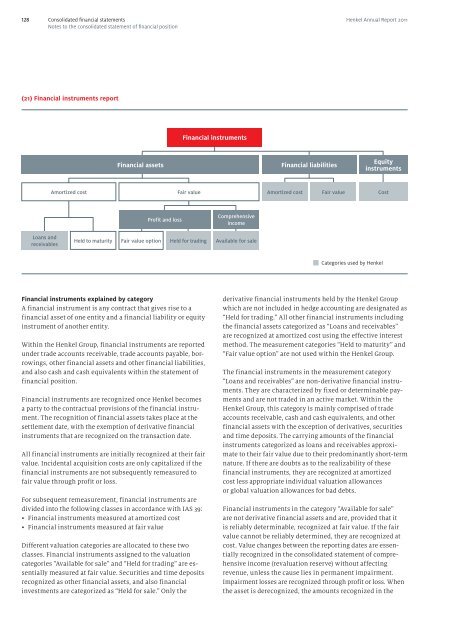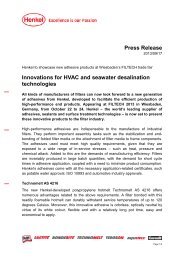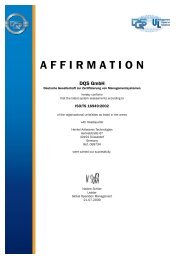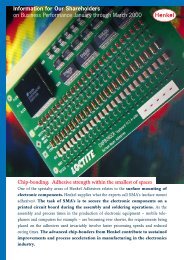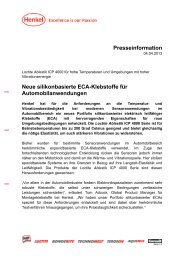Henkel Annual Report 2011 - Henkel AG & Co. KGaA Annual Report ...
Henkel Annual Report 2011 - Henkel AG & Co. KGaA Annual Report ...
Henkel Annual Report 2011 - Henkel AG & Co. KGaA Annual Report ...
Create successful ePaper yourself
Turn your PDF publications into a flip-book with our unique Google optimized e-Paper software.
128 <strong>Co</strong>nsolidated financial statements<br />
Notes to the consolidated statement of financial position<br />
<strong>Henkel</strong> <strong>Annual</strong> <strong>Report</strong> <strong>2011</strong><br />
(21) Financial instruments report<br />
Loans and<br />
receivables<br />
Amortized cost<br />
Held to maturity<br />
Financial instruments explained by category<br />
A financial instrument is any contract that gives rise to a<br />
financial asset of one entity and a financial liability or equity<br />
instrument of another entity.<br />
Within the <strong>Henkel</strong> Group, financial instruments are reported<br />
under trade accounts receivable, trade accounts payable, borrowings,<br />
other financial assets and other financial liabilities,<br />
and also cash and cash equivalents within the statement of<br />
financial position.<br />
Financial instruments are recognized once <strong>Henkel</strong> becomes<br />
a party to the contractual provisions of the financial instrument.<br />
The recognition of financial assets takes place at the<br />
settlement date, with the exemption of derivative financial<br />
instruments that are recognized on the transaction date.<br />
All financial instruments are initially recognized at their fair<br />
value. Incidental acquisition costs are only capitalized if the<br />
financial instruments are not subsequently remeasured to<br />
fair value through profit or loss.<br />
For subsequent remeasurement, financial instruments are<br />
divided into the following classes in accordance with IAS 39:<br />
• Financial instruments measured at amortized cost<br />
• Financial instruments measured at fair value<br />
Different valuation categories are allocated to these two<br />
classes. Financial instruments assigned to the valuation<br />
categories “Available for sale” and “Held for trading” are essentially<br />
measured at fair value. Securities and time deposits<br />
recognized as other financial assets, and also financial<br />
investments are categorized as “Held for sale.” Only the<br />
Financial instruments<br />
Financial assets Financial liabilities<br />
Fair value option<br />
Profit and loss<br />
Categories used by <strong>Henkel</strong><br />
Equity<br />
instruments<br />
Fair value Amortized cost Fair value <strong>Co</strong>st<br />
Held for trading<br />
<strong>Co</strong>mprehensive<br />
income<br />
Available for sale<br />
derivative financial instruments held by the <strong>Henkel</strong> Group<br />
which are not included in hedge accounting are designated as<br />
“Held for trading.” All other financial instruments including<br />
the financial assets categorized as “Loans and receivables”<br />
are recognized at amortized cost using the effective interest<br />
method. The measurement categories “Held to maturity” and<br />
“Fair value option” are not used within the <strong>Henkel</strong> Group.<br />
The financial instruments in the measurement category<br />
“Loans and receivables” are nonderivative financial instruments.<br />
They are characterized by fixed or determinable payments<br />
and are not traded in an active market. Within the<br />
<strong>Henkel</strong> Group, this category is mainly comprised of trade<br />
accounts receivable, cash and cash equivalents, and other<br />
financial assets with the exception of derivatives, securities<br />
and time deposits. The carrying amounts of the financial<br />
instruments categorized as loans and receivables approximate<br />
to their fair value due to their predominantly shortterm<br />
nature. If there are doubts as to the realizability of these<br />
financial instruments, they are recognized at amortized<br />
cost less appropriate individual valuation allowances<br />
or global valuation allowances for bad debts.<br />
Financial instruments in the category “Available for sale”<br />
are not derivative financial assets and are, provided that it<br />
is reliably determinable, recognized at fair value. If the fair<br />
value cannot be reliably determined, they are recognized at<br />
cost. Value changes between the reporting dates are essentially<br />
recognized in the consolidated statement of comprehensive<br />
income (revaluation reserve) without affecting<br />
revenue, unless the cause lies in permanent impairment.<br />
Impairment losses are recognized through profit or loss. When<br />
the asset is derecognized, the amounts recognized in the


